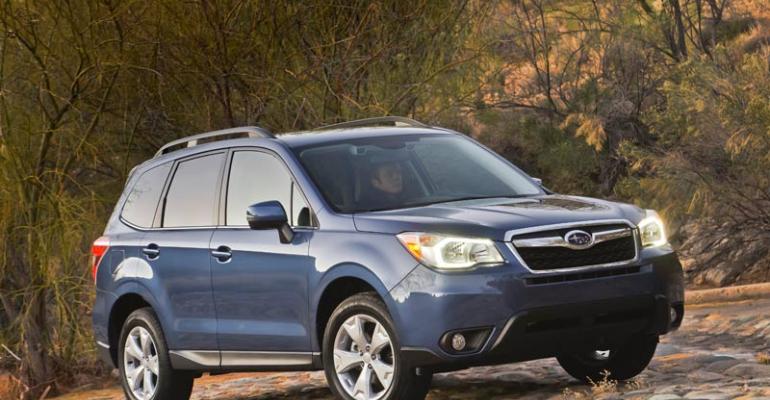TUCSON, AZ – Subaru expects the ’14 Forester cross/utility vehicle, plus a handful of other new products, to drive U.S. sales to at least 365,000 units this year, an 8% gain from 336,441 in 2012.
“Hopefully we’re underestimating (our target),” Ken Lin, director-product management, tells WardsAuto at a recent media event here. “If the market is strong and Forester launches strong, we could (surpass it).”
The goal is within reach if Subaru can maintain its current momentum in the U.S., where it has posted sales gains for five consecutive years, including during the height of the recession.
The Forester, one of the most critical products in Subaru’s U.S. lineup, is completely revamped for ’14, with a redesigned exterior and interior and a new 250-hp direct-injected turbocharged horizontally opposed 4-cyl. engine.
But there are other models in Subaru’s lineup, as well as some untapped potential, that could fuel growth this year.
The recently launched Subaru BRZ sports car, the result of a collaboration with Toyota, has been well received and created buzz around the brand. The 2-seater is powered by a 200-hp 2.0L normally aspirated flat-4 engine, a 2013 Ward’s 10 Best Engines winner.
But in the sports-car segment, excitement over a new model can fade quickly if an auto maker stands pat, Lin says, hinting an update may be in the works.
“That segment has to have something fresh to keep the interest level high,” he says. “It will be important for us to manage the lifecycle of that product.”
Lin declines to say whether the BRZ will receive a turbocharged engine, a matter of speculation among enthusiasts. Current turbocharged Subaru engines won’t fit in the BRZ’s engine bay, but officials aren’t ruling out a solution down the road.
Although the BRZ has sold only 4,144 units since going on sale in the U.S. last May, Lin says the volume is as projected. The BRZ’s twin, the Scion FR-S, has posted 11,417 deliveries to date.
“The plan was for (Toyota) to outsell us,” he says. “They have many more dealerships and they wanted to sell more of the product. This wasn’t a car that we desperately needed. But it was a great engineering exercise, and we manufacture and build it. So from a manufacturing standpoint, it’s also good for the company.”
The joint product-development program likely was a onetime collaboration with Toyota, Lin says, though he leaves the door open for future tie-ups.
However, it is highly unlikely Subaru will turn to Toyota for assistance in developing an entry-level car, Lin says. Some critics have suggested Subaru needs such a model to bring lower-income customers into its showrooms.
“We see a lot of brands that go down-market to the entry buyer, but we’re smaller and have to be very strategic on where we focus our resources,” he says. “(Entry-level) cars themselves don’t cost that much less to build, but you have to charge thousands less to be competitive so it doesn’t make a lot of sense for us at this point.”
While the BRZ’s volume was expected, the same cannot be said for the Tribeca CUV. Last year’s sales slid 25.6% to just 2,075 units, and in January only 159 were delivered, according to WardsAuto data.
Lin says the Forester may be eating into demand for the Tribeca, which also is hampered by capacity constraints at the Lafayette, IN, assembly plant. Lackluster sales ultimately could lead to its demise, he admits, although there are no plans to end production.
“Tribeca maybe isn’t the most competitive in its segment,” Lin says. “Maybe it’s a little bit too small and the fuel economy a little bit lacking, but it still offers three rows, so for young families it’s still useful.”
A larger 3-row CUV ultimately could be in Subaru’s future, he says. More upscale versions of current models also may be something the auto maker will consider, though Subaru has no intention of taking on the segment heavyweights.
“Luxury is certainly one of the opportunities with profit potential,” Lin says. “We could do touring-editions of products but would not be competing with BMW or Mercedes. There is no move to create another brand.”
Later this year, Subaru will launch a hybrid-electric vehicle into the market, but details have not been revealed. Lin will say only that the model will utilize a nickel-metal-hydride battery, not a lithium-ion pack, an indication the vehicle likely will be a conventional HEV, not a plug-in.
“Li-ion (batteries) are out there, but look at Boeing,” Lin says, referring to fire issues associated with Li-ion batteries on the new 787 jetliner. “I think at least for our first attempt (at a hybrid), we’re keeping it pretty simple.”
The hybrid isn’t expected to boost sales significantly, he adds, noting the vehicle will be offered to appease Subaru loyalists, who view themselves as environmentalists.




